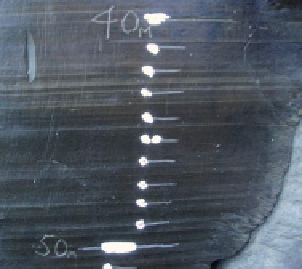Geoscience Reference
In-Depth Information
diatoms a small 10 g sample is ample. For palynology
samples of 0.5-1 kg are required.
Samples for molecular fossils:
Very small samples are required
for molecular fossils but the sample needs to be large enough
(2-5 g) to avoid contamination. The samples should be
packaged in metal foil or glass or polythene bags of known
composition. In addition care needs to be taken not to
cross-contaminate samples by carefully cleaning the sampling
instruments between each sample.
13
13.1.6 Sampling for regional studies
Regional and low-resolution studies require samples that are
representative of the whole area. In addition samples should be
collected from units that need laboratory analysis because their
composition is enigmatic. It is diffi cult to generalize here
though, as the sampling strategy will need to be adapted
according to the hypothesis being tested. Collecting a sample
from each of the main lithostratigraphic units is probably a
good place to start. If the region is fairly monolithic (for
instance a large igneous province) then take regularly spaced
samples that are spatially separated both horizontally and
vertically, in addition to other key features such as potential
feeder dykes. Other samples that are worth considering are a
set to test for compositional variation across an igneous body,
representative fossils, tectonic contacts, representative samples
from metamorphic zones and representative samples from a set
of dykes.
(a)
13.1.7 High-resolution sample sets
High-resolution sampling requires great care and patience. A
logical means of labelling the samples/sample positions will
need to be devised. In any situation where closely spaced
samples are required it is best to mark the exposure clearly fi rst
with a scale (Figure 13.2) and, if irregularly spaced samples are
required, mark where the samples will be taken from. The
exposure can then be photographed as a permanent record
before extracting the samples. Marking up the section can be
done with a tile scribe, a marker pen, paint or paper correction
(b)
Figure 13.2
Marked sections ready for sampling. Lower Jurassic,
Yorkshire, UK. (a) One stratigraphic metre of rock marked every 1 cm.
(b) Detail section showing marks every 1 cm made with a tile scribe and
correction fl uid. Note in this case the letter 'm' indicates minus as the
marks are below the zero reference datum shown in (a). (c) Marking
sections on both sides of a corner can be helpful when putting the section
back together. (a-c: Christopher Pearce, The Open University, UK.)
(c)











